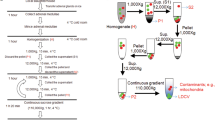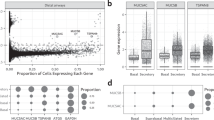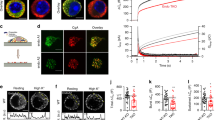Abstract
The synthesis rate of the membrane proteins of the catecholamine-storing vesicles (chromaffin granules) of the adrenal medulla is lower than that of the secretory proteins of the contents1. Based on these results we proposed2,3 that after exocytosis the membranes of chromaffin granules are retrieved and are re-used for several secretion cycles (see also ref. 4). This concept of re-use of granule membranes has been further strengthened by the finding that exogenous markers which are taken up by secretory cells during stimulation can be traced to the Golgi region and to immature secretory organelles5,6. However, one basic question remains: are the membranes of secretory organelles specifically and completely removed from the plasma membrane and if so, how fast is this process? By using an antiserum against a membrane glycoprotein of chromaffin granules we have now obtained quantitative data which demonstrate that during exocytosis this antigen becomes exposed on the cell surface and disappears again to a large degree within 30 min.
This is a preview of subscription content, access via your institution
Access options
Subscribe to this journal
Receive 51 print issues and online access
$199.00 per year
only $3.90 per issue
Buy this article
- Purchase on Springer Link
- Instant access to full article PDF
Prices may be subject to local taxes which are calculated during checkout
Similar content being viewed by others
References
Winkler, H., Schöpf, J. A. L., Hörtnagl, H. & Hörtnagl, H. Naunyn Schmiedebergs Archs Pharmak. 273, 43–61 (1972).
Winkler, H., Schneider, F. H., Rufener, C., Nakane, P. K. & Hörtnagl, H. Advances in Cytopharmacology Vol. 2, 127–139 (Plenum, New York 1974).
Winkler, H. Neuroscience 2, 657–683 (1977).
Meldolesi, J., Borgese, N., De Camilli, P. & Ceccarelli, B. Cell Surface Review Vol. 5, 509–627 (North-Holland, Amsterdam 1978).
Herzog, V. Phil. Trans. R. Soc. B296, 67–72 (1981).
Suchard, S. J., Corcoran, J. J., Pressman, B. C. & Rubin, R. W. Cell-Biol. int. Rep. 5, 953–962 (1981).
Fischer-Colbrie, R., Schachinger, M., Zangerle, R. & Winkler, H. J. Neurochem. 38, 725–732 (1982).
Fenwick, E. M., Fajdiga, P. B., Howe, N. B. S. & Livett, B. G. J. Cell Biol. 76, 12–30 (1978).
Lee, V. H., Greene, L. A. & Shelanski, M. L. Neuroscience 5, 1979–1987 (1980).
Wildman, J., Dewair, M. & Matthaei, H. J. Neuroimmun. 1, 353–364 (1981).
Schneider, F. H., Smith, A. D. & Winkler, H. Br. J. Pharmac. Chemother. 31, 94–104 (1967).
Author information
Authors and Affiliations
Rights and permissions
About this article
Cite this article
Lingg, G., Fischer-Colbrie, R., Schmidt, W. et al. Exposure of an antigen of chromaffin granules on cell surface during exocytosis. Nature 301, 610–611 (1983). https://doi.org/10.1038/301610a0
Received:
Accepted:
Issue Date:
DOI: https://doi.org/10.1038/301610a0
This article is cited by
-
Fast exocytosis and endocytosis triggered by depolarisation in single adrenal chromaffin cells before rapid Ca2+ current run-down
Pfl�gers Archiv European Journal of Physiology (1995)
Comments
By submitting a comment you agree to abide by our Terms and Community Guidelines. If you find something abusive or that does not comply with our terms or guidelines please flag it as inappropriate.



